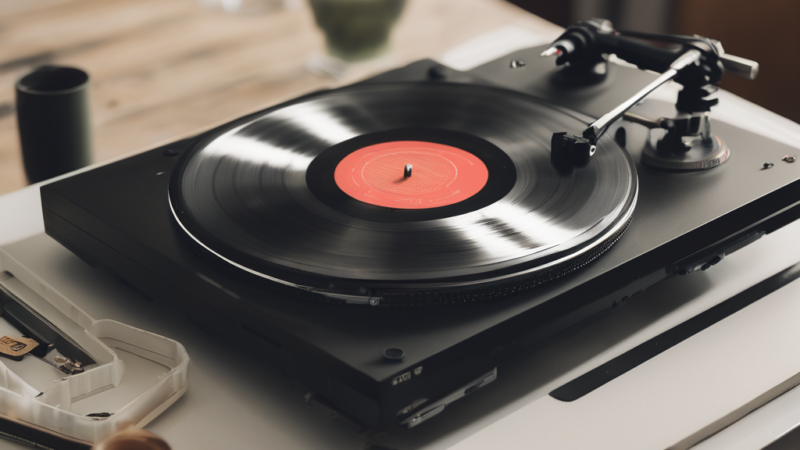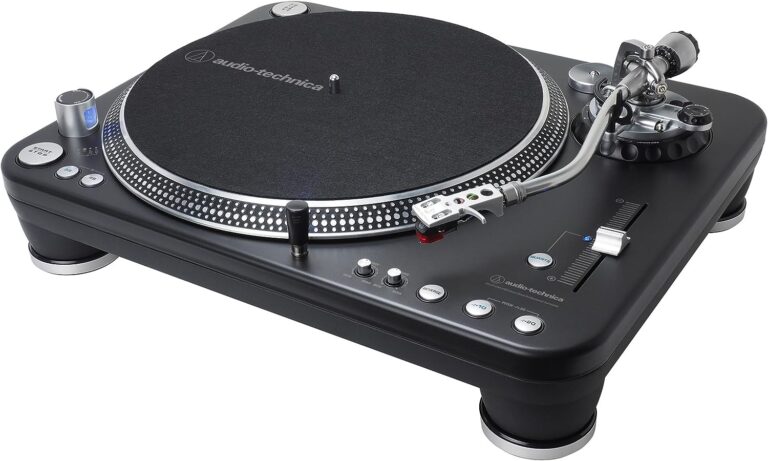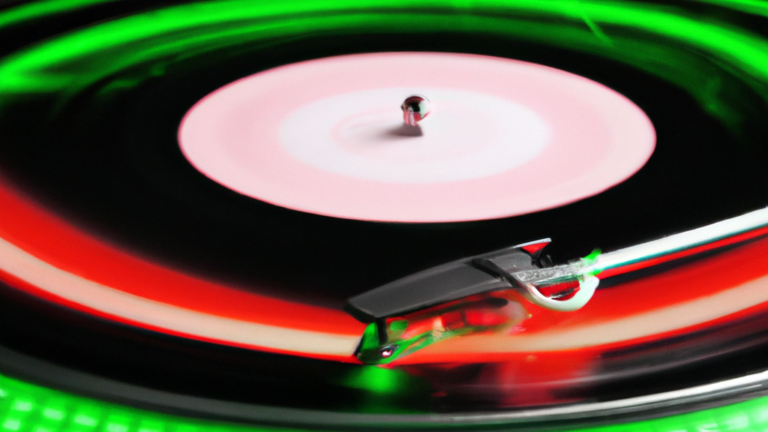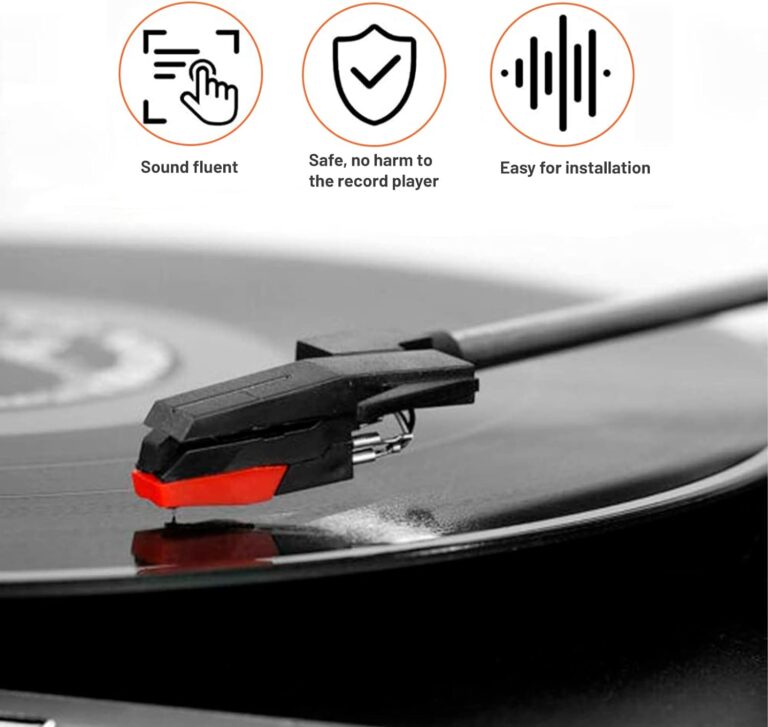How Does a Turntable Work: The Magic Behind the Spinning Vinyl
Have you ever wondered how does a turntable work? What’s the magic behind the spinning vinyl that brings your favorite tunes to life? As an audiophile, I’ve always been fascinated by the smooth blend of science and artistry hidden in this classic piece of technology.
Turntables have a unique allure, a charming blend of nostalgia, and a physical connection to the music. It’s a device that turns grooves on a record into sounds in the air. But there is so much more to it than just a needle running along a groove. It’s a journey of sound, from the stylus to the speakers, and every step on the way is an intricate dance of precision engineering.

The Basic Components of a Turntable
In understanding the anatomy of a turntable, there are several crucial components to consider. These integral components work together to produce the classic, analog sound that vinyl records are known for. The first key component is the platter, which is the rotating component that the record sits on. It is typically driven by a motor via direct drive or belt drive.
Understanding the Role of the Platter
A central fixture, the platter is where your favorite album rests, spinning at a steady RPM, allowing the stylus to track each and every harmonic sound embedded in the record. When it comes to music fidelity, the platter is paramount. Its stability reduces unwanted vibrations and resonance, contributing significantly to sound fidelity.
The tactile experience of cleaning your record and placing it onto the platter speaks to the communal listening experience often associated with analog systems. It’s a far cry from simply selecting a track from a digital library or streaming playlist. As an audio nerd, you’ll appreciate the role of the platter in bringing your record collection to life on your sound system.
The Importance of a Tonearm in a Turntable
The tonearm can profoundly impact the acoustic performance of your phonograph. Its main role is to hold and maneuver the needle as it tracks the physical media’s details. The tonearm’s balance, ensured by a counterweight, can significantly affect the needle’s interaction with the media.
This balance is paramount as it prevents unnecessary wear on your media and the needle itself. Additionally, the tonearm facilitates the transfer of the media’s information to the preamp for amplification. This is typically done via an RCA connection.
How the Stylus Contributes to Sound Quality
This tiny, often overlooked component has a tremendous impact on how we experience music. It’s the needle that interprets the coded information on the disc into rhythmic waves that our ears perceive as music.
The needle glides effortlessly over the disc at a specific RPM (rotations per minute), picking up the subtle changes and nuances embedded within. This information is then transformed into an electrical signal sent to your powered speakers, manifesting as the familiar melodies we know and love.
Bear in mind, that the needle’s condition directly impacts the music’s clarity. A worn or damaged needle might result in a less-than-satisfactory listening experience. You should regularly clean the needle for better performance.
The Function of the Cartridge in a Turntable
This little component plays a crucial role in your listening experience. It’s responsible for picking up the tiny fluctuations and nuances from the spinning disk and converting them into electrical impulses. So, when the needle glides over the surface of the spinning disk, it’s the audio converter that turns those physical movements into something the human ear can interpret as music.
Without it, the rich, deep sounds we associate with these classic music players wouldn’t be possible. It’s an integral part of ensuring you get the most out of your music experience.
The Role of the Motor in a Turntable
This crucial cog in the turntable machine powers the spinning portion that holds the disc. It’s a delicate balance to achieve the right speed consistently. If the motor’s speed fluctuates, it can affect the pitch and tempo of the music.
A good motor will maintain a steady speed, preventing distortions in the music. It’s the unsung hero of the turntable, working quietly in the background to ensure everything runs smoothly. So, when you’re enjoying that favorite tune of yours, remember, it’s the motor that’s keeping the beat.
The Mechanics of a Spinning Vinyl
So, you’ve got your head around the main components of your spin table. Now, let’s dive into the mechanics of its motion. It’s a process that’s both simple and complex.
When the motor powers up, it moves the disc on which your precious LPs rest. This motion isn’t random, though. It’s carefully calibrated to move at a specific speed, which ensures the needle tracks the disc’s ridges perfectly.
This precision movement is the secret behind the rich, warm sounds that only a spin table can produce. Understanding this interplay gives you a deeper appreciation for the artistry and science behind your favorite tunes.
The Science Behind the Sound
Understanding the science behind the sound involves looking at the intricate steps involved in playing a vinyl record. This process is a marvel of engineering and physics, smoothly transforming physical grooves into the music we hear. Let’s dive into the science behind this fascinating process.
How Grooves on a Vinyl Record Store Sound
The grooves on a vinyl record are not just ordinary indentations; they are a physical representation of sound waves. These grooves are cut into the vinyl in a spiral pattern, starting from the outer edge and moving towards the center.
Each groove is etched with a series of waves that correspond to the various frequencies of the audio recording. The left channel is represented by the left wall of the groove, and the right channel is represented by the right wall. These grooves are incredibly detailed, with even the slightest change in depth, width, or shape corresponding to a different sound.
The Role of the Stylus in Reading These Grooves
The stylus, or needle, plays a crucial role in reading these complex grooves. As the record spins, the stylus traces the grooves’ pattern. The stylus, normally made of diamond or other hard materials, is designed to accurately follow the minute variations in the grooves’ shape without causing significant wear. This movement of the stylus then translates these physical indentations back into sound waves.
Conversion of Mechanical Energy (Groove Vibrations) into Electrical Signals
As the stylus navigates the grooves, it vibrates, and these vibrations are translated into electrical signals by the cartridge, which houses the stylus. This is achieved through the process of electromagnetic induction. Inside the cartridge are tiny coils of wire located near a magnet.
As the stylus moves, it causes the coils to move relative to the magnet, creating a fluctuating magnetic field. This fluctuating field induces a current in the coil, producing an electrical signal that mirrors the original sound waves.
Amplification of These Signals to Produce Sound
Once the electrical signals are generated, they are still too weak to drive a loudspeaker. This is where the amplifier comes into play. The amplifier boosts these electrical signals to a level that can drive the loudspeaker. This amplified signal is then sent to the speakers, where it’s converted back into mechanical vibrations that move the speaker cones to produce the sound waves we can hear.
In conclusion, every time we play a vinyl record, we are observing a complex process where physical grooves are translated into electrical signals, amplified, and then turned back into sound waves. It’s a testament to the power of science and engineering that we can produce such high-quality sound from a physical medium like a vinyl record.
Turntable Varieties and Their Differences
In the world of audio equipment, turntables are a classic piece of gear that has seen a resurgence in popularity in recent years. Understanding the varieties of turntables and their differences can help consumers and audiophiles make more informed purchasing decisions.
Belt-Drive vs. Direct-Drive Turntables
In one corner, we’ve got machines that use a belt. These decks are often applauded for their reduced motor noise and vibration, thereby enhancing the auditory experience. However, they may require a bit more TLC, as the belt can wear out over time.
In the other corner, you’ve got your directly driven models. These bad boys don’t bother with belts and instead rotate via a motor directly connected to the disc. This design offers better speed control and less hassle, but it can lead to more mechanical noise.
You might interested in a detailed comparison of belt-drive vs direct-drive turntables.
Manual vs. Automatic Turntables
Having nailed down the art of setting up your turntable, another significant decision you’ll need to make is between manual and automatic turntables. Manual turntables require you to physically lift the needle place it on the disc, and remove it when finished. This does provide a certain hands-on, immersive experience, but it also leaves more room for error and potential damage to your discs.
On the other hand, automatic turntables do this work for you, ensuring precision and reducing risk, but you’ll miss out on that interactive component. It’s a matter of personal preference, so consider the level of involvement you’re interested in when making your choice.
Vintage vs. Modern Turntables
When it comes to antique turntables, they’re beloved for their charm and richness of history. They often require a bit more care and attention, and they provide a unique listening experience that’s hard to replicate. Their designs are often ornate, and their mechanisms can be more complex than what you’d find in today’s designs.
On the other hand, contemporary turntables are all about convenience and ease of use. They’re typically equipped with the latest tech, which can boost performance and make your listening experience more straightforward.
The Vinyl Experience
There’s something irreplaceably satisfying about sliding a platter out of its sleeve, gently placing it on a deck, and setting the needle down. It’s a physical, interactive process that digital formats just can’t replicate. The very act of handling records adds a tangible dimension to music that we believe enhances the overall experience.
The sound, too, is uniquely captivating. The warmth and depth of music played through a deck is something to be savored. It’s not just about the notes you hear, but the whole sonic experience. There’s a richness and character to the music that can make you fall in love with your favorite songs all over again.
FAQs
Why is vinyl making a comeback?
It’s a mixture of a few factors. For one, there’s nostalgia. Many of us remember the days of our youth when we’d flip through LPs and experience the joy of discovering a new favorite tune. Additionally, the physical aspect of handling LPs and the artwork that accompanies them offers a more immersive experience. Lastly, many believe these formats provide a richer and more nuanced listening experience, often described as a warm or natural sound.
How do turntables compare to modern music players?
Comparing a turntable to current music devices is somewhat like comparing a vintage automobile to a spaceship. Sure, they’re both modes of transportation, but they offer vastly different experiences. The charm of a turntable lies in its tangible nature, the physical interaction it commands, and the nostalgia it evokes. This contrasts with the convenience, accessibility, and vast musical choices that contemporary digital music platforms offer. Ultimately, it comes down to personal preference.
Can old records be played on new turntables?
Yes, they certainly can. However, it’s important to remember that compatibility isn’t the only consideration. You have to factor in the condition of the older discs and the delicacy of your newer turntable. Older music discs, especially if they have not been properly cared for, can cause damage to your newer turntable’s components. So, while it’s technically possible to play older discs on newer turntables, take extra precautions to ensure the longevity of your equipment.
Can I play any vinyl record on any turntable?
In essence, it’s possible. However, it’s essential to remember that the size of the disc and the speed at which it should be played are critical factors. Some apparatuses may not be compatible with all disc sizes or speeds. So, while it’s generally acceptable, you’ll want to ensure that your particular apparatus can accommodate the disc you intend to play. This ensures you get the best possible listening experience.
Why is vinyl considered to have a “warmer” sound than digital music?
The notion of vinyl producing a “warmer” sound as compared to digital music is largely subjective and is deeply rooted in the unique characteristics of the vinyl recording and playback process. Vinyl records are analog recordings, which means they capture the original waveform of the sound being produced.
Conclusion
In the end, there’s something inarguably magical about the whirring disc and its ability to bring forth music. The science, artistry, and varieties of the spinning disc player create a uniquely immersive experience that’s hard to match.
Moreover, caring for your device and the discs themselves is a labor of love that enhances the overall satisfaction of the experience. Take time to answer all your queries, because every bit of knowledge enriches the joy of using this fascinating device.






